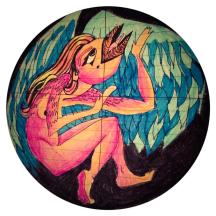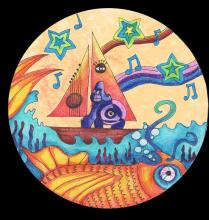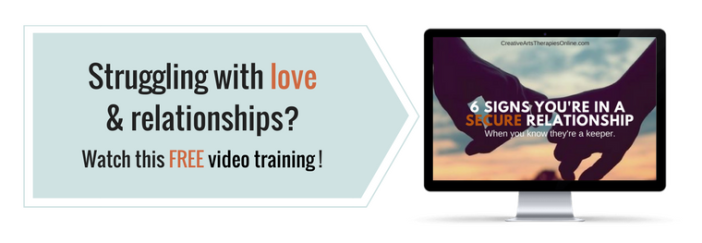What is Creative Arts Therapy?
Do you find yourself struggling with:
- Intimate relationships and getting your needs met?
- Constantly seeking new relationships and surfing online dating sites?
- Perpetually stuck in one dissatisfying, co-dependent relationship after another?
- Avoiding your feelings because they lead to constant worrying?
- Poor body image and loose sexual boundaries?
- A lack of meaning and purpose?
- Using food, drugs, alcohol, sex or other behaviors to cope with anxiety?
- A history of anxiety, impulsivity, depression or trauma?
Creative Arts Therapy can help you achieve:
- Healthier relationships
- Improved self esteem
- A deeper sense of meaning and purposefulness
- Control of compulsive and/or addictive behaviors
- Strong personal boundaries
Creative Arts Therapy is a form of psychotherapy that uses art and other forms of expression to explore therapeutic issues. Creativity is the language of the unknowable, divinely loving, and magical part of ourselves that needs to be unearthed and recovered, in order to heal, in all facets of our lives. Please read on to learn how rediscovering your essential artist will put you on the path to healing.
The Essential Artist in All of Us
Here we go again…
 Do you ever find yourself wondering why you always end up in the same type of relationship, over and over again? No matter how hard to try to find someone different, a few months in, you’re still struggling with the same old problems? Or maybe you simply fall into relationships, always harboring a nagging ambivalence about how you really feel about this person. Maybe you avoid the anxiety it causes by working extra hard, or having that extra drink. Maybe you surf online dating sites, slipping into imagined (or real) affairs. But deep down, there’s a rooting vacancy. A consistent sense of boredom. An emptiness that nothing seems to fill, and a frustration at not being able to fix it.
Do you ever find yourself wondering why you always end up in the same type of relationship, over and over again? No matter how hard to try to find someone different, a few months in, you’re still struggling with the same old problems? Or maybe you simply fall into relationships, always harboring a nagging ambivalence about how you really feel about this person. Maybe you avoid the anxiety it causes by working extra hard, or having that extra drink. Maybe you surf online dating sites, slipping into imagined (or real) affairs. But deep down, there’s a rooting vacancy. A consistent sense of boredom. An emptiness that nothing seems to fill, and a frustration at not being able to fix it.
This is the result of an over-reliance on a “false self” and the neglect of festering wounds.
As adults, we set ourselves up by finding partners that confirm our early models, even when these patterns hurt us and are not in our own self-interest. For example, in a romantic relationship, a woman with an anxious ambivalent attachment may feel she needs to be with her partner all the time, to gain reassurance and feel loved. To support this perception of reality, she chooses someone who is isolated and hard to connect with. “See? If I didn’t hound him all the time, he’d never express his feelings or show me affection.”
Similarly, her partner, who has a model of avoidant attachment has the tendency to choose someone who is possessive or overly demanding of attention, from whom he constantly needs to escape. “See? I have to be distant, otherwise her constant hounding would suck me dry.” These cyclical patterns leave one in constant emotional and physical pain, over failed relationships. Add in other complicating factors such as abuse, addiction, trauma, divorce, adjustment issues, fears of intimacy, and grief, and its a recipe for clinical depression, anxiety, and a host of other problems.
How did this happen?
 Somewhere along the line, these patterns of attaching and relating served a protective function. Through various interactions with his parents, a child learns certain thoughts and feelings are unacceptable and should be eliminated. So, he creates an imaginary parent in his head to police his thoughts and feelings, what psychodynamic theory would refer to as the “superego.” Thus, whenever he has occasion to experience those unacceptable emotions, he receives a jolt of anxiety and represses them, burying them in his unconscious. Because these repressions are met with external approval, we may come to view these “defense mechanisms” as our greatest strengths. As we mature, however, they may prove to be our biggest crutches.Best selling author and therapist Harville Hendrix calls this “loss of God-given wholeness” the “ultimate sacrifice to obedience,” which leads to a fracturing of the unified self you were born with, into three parts:
Somewhere along the line, these patterns of attaching and relating served a protective function. Through various interactions with his parents, a child learns certain thoughts and feelings are unacceptable and should be eliminated. So, he creates an imaginary parent in his head to police his thoughts and feelings, what psychodynamic theory would refer to as the “superego.” Thus, whenever he has occasion to experience those unacceptable emotions, he receives a jolt of anxiety and represses them, burying them in his unconscious. Because these repressions are met with external approval, we may come to view these “defense mechanisms” as our greatest strengths. As we mature, however, they may prove to be our biggest crutches.Best selling author and therapist Harville Hendrix calls this “loss of God-given wholeness” the “ultimate sacrifice to obedience,” which leads to a fracturing of the unified self you were born with, into three parts:
- Your “lost self”—the parts that were repressed due to the demands of culture and society
- Your “false self”—the façade you create to fill the void and created by this repression and by a lack of nurturing
- Your “disowned self”—the negative parts of your false self that were met with disapproval and were therefore denied
Another term to describe this situation, coined by best selling author and therapist John Bradshaw, would be “the wounded inner child.” Best selling author and spiritualist Eckhart Tolle would call this a “pain body,” with its own consciousness and malignant need to survive, by keeping you in a constant state of suffering. Certain approaches in talk therapy would only feed this pain body, because the focus is on learning more about the pain body, not on differentiating your true self from it altogether.
How to heal?
 A reasonable person might assume analyzing pivotal moments in childhood will resolve his troubles, turning talk therapy into a treasure hunt for the explicit past. Autobiographical memories are useful, but explicit memory is not a shrine. People rely on the rational mind to solve problems, and are baffled when it proves useless to effect emotional change. Recounting a timeline of your past alone will not help you navigate out of these muddy waters. You have to engage in relationships, see what comes up in the present, and be able to withstand the discomfort.
A reasonable person might assume analyzing pivotal moments in childhood will resolve his troubles, turning talk therapy into a treasure hunt for the explicit past. Autobiographical memories are useful, but explicit memory is not a shrine. People rely on the rational mind to solve problems, and are baffled when it proves useless to effect emotional change. Recounting a timeline of your past alone will not help you navigate out of these muddy waters. You have to engage in relationships, see what comes up in the present, and be able to withstand the discomfort.
I refer to the “true self” as the entirety of one’s being, capable of perceiving the whole of experience–not simply the parts we choose to acknowledge. Creativity is essential to this. So is fantasy. And the ability to understand real events through felt experiences, as opposed to insisting on a revision of perception through a logical narrative. I like to think of one’s true self as his or her essential artist.
How can I help you?

Your essential artist cannot be reduced to your “inner child” but it might be helpful to imagine a moment from your youth when you felt limitless and exuberant. Perhaps it was a moment when you fancied yourself a superhero, donned a cape, and jumped from chair to couch, zipping around the room. Maybe you fancied yourself the queen of the castle, built a fort made of pillows, and only allowed your pet dog—the court jester—to enter. Maybe you thought you could fly. For the child, symbols come alive not only in image, but in reality. Their sense of “being” is closer to that of a “true self” because it has not yet been chipped away by the brick wall of reality. In other words, the boundaries between what could be, and what we later convince ourselves to be impossible, are still blurred.
Creative arts therapists have been playing with those blurred boundaries for years, discovering lost capes and magical castles. Creativity utilizes a universal language of the body, metaphors, images and symbols, that allows for emotional flexibility and the revision of seemingly unchangeable patterns of loving and mourning.
As a creative arts therapist, it is my goal to provide outstanding flexibility, creativity, empathy, and insight to my clients. In ten years of clinical practice, I have developed a more directive, mind-body approach, taking into account all aspects of the human experience, including the biological, mental, spiritual, and emotional components. To learn more about my qualifications and experience, my stylistic approach and/or to review a sample treatment plan, please see the about section of this website, and feel free to contact me with any questions.

